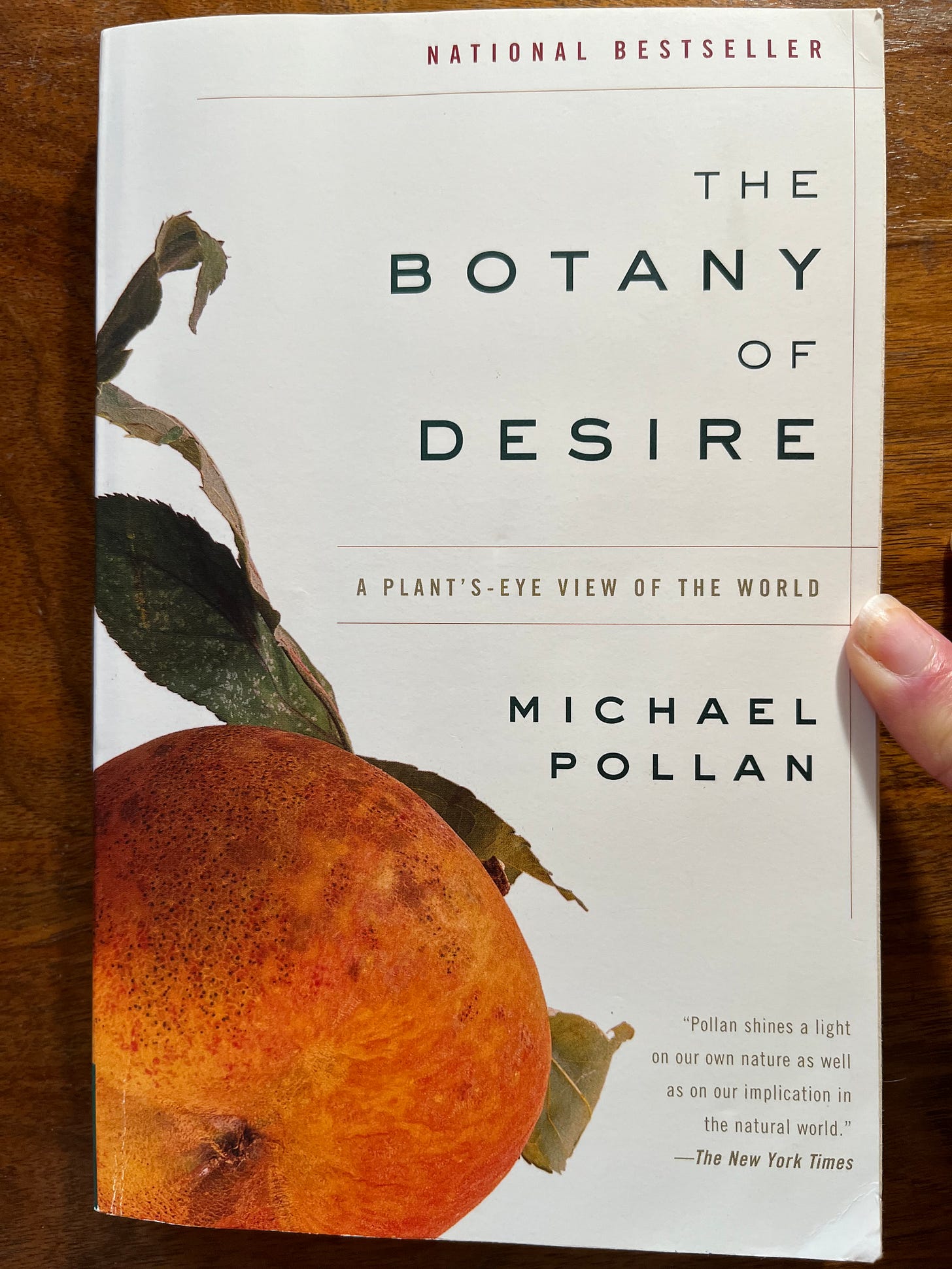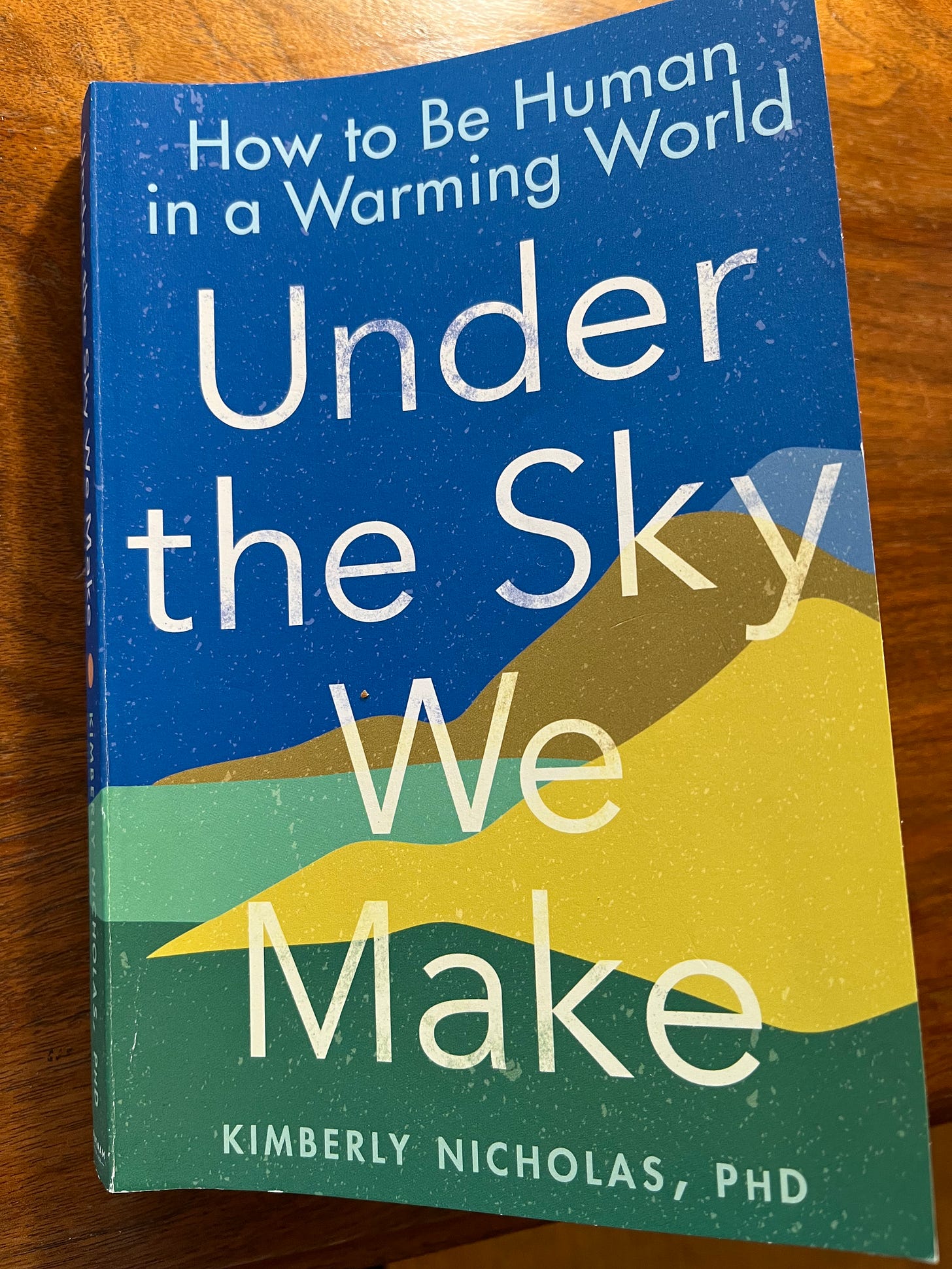Book Reviews: The Botany of Desire & Under the Sky We Make
How do plants shape people—and evolve together with us? Plus, a climate scientist offers a path to a more livable future.

Welcome! You’re at Mother E, a newsletter exploring our kinship with nature in a climate-changing world. If you missed the last edition, it’s viewable here: On the Wings of Spring
If this newsletter gets shortened by an email program or the images don’t show, you can read it on the website here.
I'M REVIEWING TWO BOOKS here and "mining" them for their wisdom and insights. The beauty of reading a book, as opposed to a short article, is that there is a leisurely and deeper reveal of the subject and its understanding. It's like the difference between meeting a friend for coffee vs. spending a week on vacation together. In fact, many books have accompanied me on vacations as "companions.”
One reason readers love books—physical, digital, or audio—is because they're a place authors reveal their unique insights and how they reached new perspectives. There's often a story behind the insights, like a trail of breadcrumbs that led someone to a better understanding.
Where do these insights come from? Those "aha" moments, when you see something from a different perspective, may be sparked by recognizing new relationships or connections between things. They can reveal a fresh possibility or pose a question that makes us think more deeply.
The challenges of the world today require:
Trying out new ideas
Exercising imagination
Finding improved ways of connecting, restoring, and relating to the natural world and each other
The books that follow may stimulate fresh ideas or motivate in new ways. Enjoy!
The Botany of Desire
In The Botany of Desire— A Plant’s Eye View of the World (published by Random House), Michael Pollan's insights are rich, relevant, and tantalizing. The author, a master gardener and Univ. of California professor of writing, takes us on a literary romp relating to four members of the plant world: apple trees, tulip flowers, marijuana plants, and potato plants.
He explores the human desires for sweetness (apple), beauty (tulip), intoxication (marijuana), and control (potato) through the cultivation of these plants over time. He muses on the potentially subversive idea that these plants have controlled us as much as we controlled them.
Through our desire, we carried their seeds, bulbs, and tubers much further than the plants would have spread on their own. We deeply assisted their development to become dominant plant species in modern times. Pollan claims these plants worked on our desires through the give and take of mutual genetic selection.
Michael Pollan is a storyteller who takes us inside the soul of a plant. He wraps historical research and evolutionary biology together with a keen love of plants and entertaining prose.
About ten thousand years ago, the world witnessed a second flowering of plant diversity that we would come to call, somewhat self-centeredly, "the invention of agriculture."
A group of angiosperms refined their basic put-animals-to-work strategy to take advantage of one particular animal that had evolved not only to move freely around the earth, but to think and trade complicated thoughts. These plants hit on a remarkably clever strategy: getting us to move and think for them. […]
Our grammar might teach us to divide the world into active subjects and passive objects, but in a coevolutionary relationship, every subject is also an object, every object a subject. That's why it makes just as much sense to think of agriculture as something the grasses [wheat and corn] did to people as a way to conquer the trees.
Michael Pollan
Johnny Appleseed and the evolution of Malus Pumila
Pollan's first subject, the apple, has been dubbed an icon of America. You may have heard the old saying, "As American as mom and apple pie." It implies that apples are a fruit originating on the American continent. In reality, the apple we eat today started with strange-shaped wild apple trees of Kazakhstan in Central Asia, its fruits only the size of olives. Travelers then brought them to Europe and later America.
After apple trees and seeds were transported to the Americas, the fabled Johnny Appleseed (John Chapman) promoted their spread by seed across the U.S. frontier states in the early 1800s. The author follows in Chapman's footsteps, even boating down the Ohio River to see the remnants of the orchards he planted along its banks and hearing tales about Johnny Appleseed's eccentric life devoted to promoting apples.
One wonders if the fruit found Chapman just when it needed to push into this new-to-itself continent. It was a strange partnership filled with physical privation on Chapman's part and rapid spread on the apple's side.
Interestingly, early forms of American apples were small, tart, and used only for cider-making. It took many generations of natural genetic selection and apple cultivators to produce the large, sweet fruit they are today.
Early apples were planted from seed, but apple seeds do not grow true to their parent. It took grafting the best trees to get to the fruit we enjoy today. Thousands of varieties got lost along the way, although some historic "library" orchards remain.
The craving for beauty and intoxication
Michael Pollan next explores our desire for beauty. He asks who flowers appeal to and how that changes the flower over time as it seeks to attract the pollinators it needs for fertilization or the people it needs to carry and cultivate it. The Holland tulip craze of the 1600s turned tulip bulbs into a form of valuable currency and altered the flower's appearance.
He follows with a section on marijuana, our desire for intoxication, and how that has shaped the plant widely grown today and how it alters the people who use it.
The book ends with the potato plant, its wild version originating in Peru and Bolivia, but now cultivated worldwide and greatly changed by genetic modification and human control. I'm still reading this book, but it's been stimulating so far.
The Mother E newsletter is about our kinship with other species in a climate-changing world. This fascinating book delves into the ability of species to change each other in remarkable ways. 🍎
Under the Sky We Make
The second book I've read recently is Under the Sky We Make—How to Be Human in a Warming World by Kimberly Nicholas, Ph.D. and published by G.P. Putnam’s Sons.
Nicholas is a leading "global sustainability scientist" who was present at the United Nations Paris Agreement and currently teaches in Sweden as a sustainability professor. She included dozens of experts in writing this book.
Under the Sky We Make is a well-rounded guide about how we created today's climate crisis and the solutions to get out of it. She relates personal stories of her California upbringing in a Napa County wine region now imperiled by frequent fires. As a scientist, she agonizes over the high carbon costs of flying and charts a personal path to a meaningful, more sustainable life.
Nicholas is a fact-sharer, moral compass, and guide to what we must do to bring the world back on track to more livability and fewer climate catastrophes. She and other climate scientists run the numbers to tell us goals for a livable planet.
Going from 16+ tons/ year per person down to 2.5 tons
What's one goal? Reduce every person's carbon footprint to 2.5 tons per year by 2030, only seven years from now.
Today, the average American produces about 16 tons of greenhouse gasses, a major contributor to global warming. If you fly, add more tons to that number for every trip overseas. Overall, we have to radically reduce these pollutants in a short period of time to keep within a livable planetary system.
It will take a shift of values and a change of attitude about our personal habits. In addition, we need faster development of green transport, low-carbon heating and building, and a faster move towards regenerative agriculture and more plant-based eating.
Many of these trends are already underway but need more individuals to promote and live them. There is power in numbers.
Dr. Nicholas talks about shifting our values towards life-sustaining practices and restoration and away from the exploitation of Earth's living species and vulnerable people.
The benefits of changing direction are numerous: better physical and mental health, fewer damaging storms, heat waves, and loss of property/life, preservation of places and species we love, and ultimately a livable future.
She has a chapter on facing climate fears that reminds us to pay attention to ALL the feelings but remember that we have the ability to act rather than sink into a "climate doomer” state.
When we don’t focus on helping actions, maybe because we feel our influence is too small or we’re pessimistic about the future, the result is the same as being a climate denier.
Rather than extrapolating the current darkness to despair, we need to work backward from the world we love rather than the one we fear. […]
You don't have to be perfect. You just have to be brave.
Your values are a clue to what to do
Dr. Nicholas reminds us to check in with our values and ask three questions.
What kind of a person am I?
What kind of situation is this?
What would a person like me do in this situation?
I'd like the answer to the first question to be: I am someone who cares for others, who takes responsibility for my actions, who does the right thing even when people around me might not.[…]
As for the situation: Climate change is an emergency, and it's time we started treating it like one. […]
What does a good-hearted person do in an emergency? They look for ways to help, and they pitch in where they can. They assess their assets and liabilities, talents and communities, and figure out how to mobilize them towards protecting people and nature, reducing harm at its source, and increasing resilience.
Kimberly Nicholas, author
This book is a worthy read— equal parts relevant personal stories and a clarifying report card for the state of our world’s climate. It offers guidance through the growing crises and a nudge to join with others to promote a world we love.
Robin Applegarth
I like to hear from readers!
Have you been inspired by any non-fiction books that explain the natural world in a new way?
What do you feel is the biggest impediment to solving our planet’s climate crisis?
You can comment at the button above, respond to your subscriber email to reach me privately, or reach out on Twitter @RobinApplegarth. If you liked this article, hit the heart ❤️button at the bottom as it helps more people find it. Thank you to readers who have referred Mother E newsletter to friends and shared on social media!
Not subscribed yet? Mother E is a free newsletter about our connections to other species in a climate-changing world. Sign up below to have it delivered to your email box every two weeks on Sunday.




Thanks Robin. I like the book reviews so I don’t need to read those books now. I get the gist of them now.